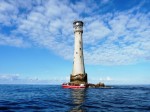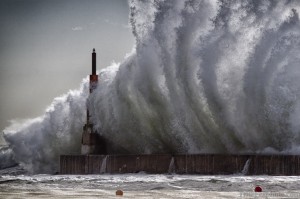Mise Tales Thirty-Two
For an update on what a Mise Tale is then please see Mise Tales One.
Click the image or use this link to see the National Geographic article If All the Ice Melted.
****************************
Navigational Light to be Fixed Atop Marriott Hotel
May 16, 2013 by KNEWS filed under news

Port Georgetown Lighthouse, Guyana
The Marriott Hotel will have a revolving light atop as a navigational aid for vessels leaving and entering Port Georgetown. In fact, even as the hotel is being constructed the contractor is expected to have the light in place and functional.
A source close to the management of the Maritime Administration Department (MARAD), said that the Marriott Hotel when completed will be taller than the lighthouse. The structure will obstruct light emanating from the 103-foot lighthouse located at Kingston.
But Cabinet Secretary, Dr. Roger Luncheon at his post-Cabinet press briefing last Thursday said, “This revelation has not been brought home to Cabinet about another reason for disparaging this transformative project initiative (Marriott). Now we are interfering with light from the lighthouse.”
Dr. Luncheon jested that a new improved light house would be constructed.
However, according to the source, the lighthouse would not be obsolete since it will still function as a navigational aid for vessels travelling south. Meanwhile, vessels travelling in the northern direction will be guided by light originating from the light affixed to the Marriott Hotel. – . . . more
[private] According to the source, management of MARAD had discussions with the Chinese firm, Shanghai Construction Group constructing the hotel on the importance of having this important navigational aid in place as soon as possible.
The contractor was informed of the specific light that would need to be procured and the manner in which the light has to function effectively.
The source noted that MARAD has not received any formal complaints regarding the hotel blocking the light from persons who require the navigational aid. [/private]
************************
 Bishop Rock: The Smallest island in the World by Kaushik Friday, July 19, 2013
Bishop Rock: The Smallest island in the World by Kaushik Friday, July 19, 2013
Bishop Rock is a small rocky ledge jutting out of the sea, 4 miles west of the Isles of Scilly in Cornwall, UK. The rock rises from a depth of 45 meter to expose a tip 46 meters long by 16 meters wide. On this narrow ledge stands a lighthouse, which makes Bishop Rock the world’s smallest island with a building on it, as recognized by the Guinness Book of Records.
The rocks around the Scilly Isles caused the wreck of many ships over the years. When Sir Cloudesley Shovel’s squadron of the British Fleet sank in 1707 along with 2,000 men, the Elder Brethren of Trinity House decided that the lighting of the Scilly Isles, which at that time consisted of only the old lighthouse at St. Agnes, was inadequate, and resolved to build a lighthouse on the most westerly danger, the Bishop Rock. . . . more
[private]
James Walker, Engineer in Chief to Trinity House, was against building a solid granite tower on Bishop Rock arguing that the rock ledge was too small and the elements too powerful. He claimed that such a tower would not withstand the tremendous force of the seas, demonstrating that the wind pressures here sometimes exceeded 7,000 lb per square foot.
So in 1847, it was decided to erect a screw-pile lighthouse at a cost of £12,000. The first task was to sink cast iron legs into the solid granite, braced and stayed with wrought iron rods. The idea was that the waves would crash right through the piles instead of slamming into a solid masonry tower. Within two years the structure was complete and all that was required was a lighting apparatus. Before it could be completed the following season, a heavy gale swept away the whole structure on the evening of 5th February 1850.
James Walker shrugged off the news and this time turned to the idea of a granite tower. It was a dangerous task, because the sea was rough and the island too small. The workmen had to be housed on a small nearby uninhabited islet, where living quarters and workshops were erected. The men were carried to and from the site as the weather permitted All the granite were brought over from the mainland to the island depot where it was shaped and numbered before being sent to the rock. After seven years labour the tower was finally completed in 1858.
In the old days the 49-meter lighthouse had to rely on paraffin vapour lamps and, before that, candles. Today there are generators and batteries and a helipad was built in 1976. Bishop Rock was converted to automatic operation in 1991 and the last keepers left the lighthouse in December 1992. Today the lighthouse has ten floors, and up to four visitors can stay here for a week to three weeks. [/private]
****************************
[su_video url=”http://vimeo.com/76166406″]
A beautiful video showing what they call “The Wettest Side of British Columbia (BC)” but which I would say shows the way we travel around BC – by foot, boat, helicopter, float plane! The film also shows at the beginning Carmanah Point lighthouse on the west coast of Vancouver Island, Point Atkinson lighthouse off Vancouver Harbour, and Brockton Point lighthouse in the inner harbour. Good film!
*************************
One of the things you have to learn when operating a radio transmitter is the INTERNATIONAL Phonetic Alphabet, so that if the reception/transmission is bad, you can still get your message through by spelling it phonetically. In the days of working HF radio (high frequency radio) it was mandatory – now it is used mainly for foreign sounding words or names, or to clarify a misheard word. The photo at the right gives the INTERNATIONAL Phonetic Alphabet. Be warned, there are many other versions out there.
*******************************
Picture of the Day: The Power of the Ocean from the Twisted Sifter website.
Photograph by TIAGO PINHEIRO
Website | Flickr | Facebook | Prints available
In this perfectly timed photo by Tiago Pinheiro, we see huge waves crashing into the pier at Praia da Aguda in Vila Nova de Gaia, Portugal. The waves were the result of a powerful storm at sea on October 15, 2012.- . . . more



